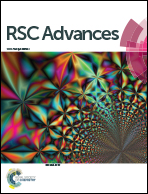Controlled deposition of Pt nanoparticles on Fe3O4@carbon microspheres for efficient oxidation of 5-hydroxymethylfurfural
Abstract
2,5-Furandicarboxylic acid (FDCA) is an important environmentally benign and sustainable chemical which can be derived from biomass and produced by the oxidization of 5-hydroxymethylfurfural (HMF). However, the oxidation of HMF relies highly on catalysts to improve the yield of FDCA. In this study, a series of novel superparamagnetic Pt nanoparticle-containing catalysts with a core–shell structure (Fe3O4@C@Pt) were synthesized and applied for HMF oxidation. These novel spherical catalysts possess a Fe3O4 core and a protective amorphous carbon shell with a surface decorated by Pt nanoparticle clusters. By changing the synthesis temperature, the morphology of the active Pt species on the carbon shell of the microspheres can be transformed from highly dispersed nanoparticles to nanoparticle clusters. The catalytic HMF oxidation results reveal that microspheres decorated with larger nanoparticle clusters (110-Fe3O4@C@Pt) have the best catalytic activity for HMF oxidation, owing to a unique islet morphology coupled with the high-degree crystallization of Pt nanoparticles. The yield of FDCA could reach 100% after 4 h of reaction at 90 °C in water which is superior to previous reports. Furthermore, this catalyst can be reused at least three times without significant performance loss.


 Please wait while we load your content...
Please wait while we load your content...